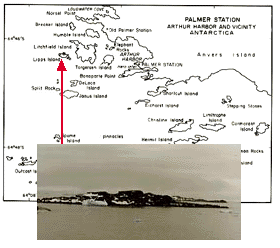|
Jere H. Lipps: Path to UCMP |
|
| Lipps can still recall the moment when he first decided to become a paleontologist. When he was seven years old, he was reading one of his Donald Duck comic books and came across a sequence in which Donald’s three mischievous nephews run through a museum filled with dinosaur skeletons. In one frame of the comic strip, they pass a closed door labeled “Paleontologist.” Lipps decided that whatever the word “paleontologist” meant, he would like to be one-he couldn’t imagine a more coveted job than one in which he could spend all day surrounded by enormous dinosaur bones. He became addicted to field work early on. When Lipps was ten years old he accompanied his father on mineralogy field trips, and observed real scientists at work. Lipps watched geologists as they mapped sites, and even today recalls his own fascination with the rock formations he encountered. It seemed to be “one giant puzzle,” and best of all the work could be done outside. |
|
|
Lipps’s love for the field led him to UCLA, where he earned his undergraduate degree in geology. During his sophomore and junior years, he explored private-sector research opportunities with various oil companies, who hired him to collect and analyze microfossil samples for use in oil exploration. During those years, he also became associated with the Los Angeles County Museum of Natural History and began working on the paleontology of the Channel Islands, off the coast of Southern California. This field work resulted in collections of Pleistocene fossils and collaborations with Jim Valentine, Ed Mitchell, and Loye Itolmes Miller. Here Lipps established his research style—field work on interesting problems, not particular fossil groups. Papers published then dealt with birds, marine mammals, mollusks and foraminifera, but all focused on paleoecology.
As his college years came to a close, Lipps chose independence over job security and went on to UCLA’s PhD program in geology. He blazed through his graduate career, earning his degree in a mere three and a half years. Lipps’s career path never left the UC system. After UCLA, he accepted a position as Assistant Professor in the Geology Department at UC Davis, and joined a team of paleontologists there that included Jim Valentine, Dan Axelrod and Richard Cowen. They set out to create a nationally-recognized program in paleobiology, including field courses in marine biology, paleontology and geology. The program was soon a success and graduate students came from all over. It was an exciting time, but in 1988, Lipps saw new opportunities at UC Berkeley. The departments of biology and paleontology were merging into a single department, Integrative Biology; and new goals for the Museum of Paleontology were made possible by new hires, better equipment and improved physical space as the museum moved into its new home in the Valley Life Sciences Building. Being part of that dream was just too much to pass up, so after 21 years at UC Davis, Lipps became a Professor at UC Berkeley and a Curator in the Museum of Paleontology. His final words to those considering a career in science: “Go for it!”
|
|
| Browse the Interview: Profile | Research | Teaching & outreach | Path to UCMP | |
| Home | What’s new | About UCMP | History of life | Fossil collections | Other resources | |
